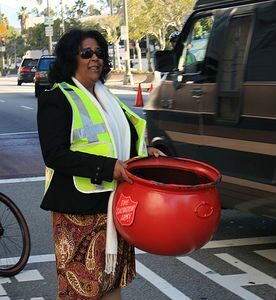Why Does it Take 20 Years to Build A Shopping Center in South Central?

The 20-year struggle to get a shopping center built at Slauson and Central reveals long-standing problems with the politics of development in L.A.
USC's Annenberg Center web site "South Los Angeles Project" tells the tale of political influence and questionable business partners at length. The $20-million dollar project is in the hands of the controversial Concerned Citizens of South Central Los Angeles (CCSCLA):
Over the past 10 years, the nonprofit CCSCLA has been sued for breach of contract by the City, sued by construction contractors for nonpayment of invoices, and audited by the state controller over grants to build soccer fields.Opponents of the group claim a political connection with City Council member Jan Perry -- often mentioned as a candidate for the city's next mayor -- helped to deliver the project at Slauson and Central to Concerned Citizens.... ...opponents of Concerned Citizens are questioning how were they selected for the Slauson-Central project in the first place. The project, which will include $7 million in public subsidies, would be developed by a partnership with Concerned Citizens and Regency Partners, the largest grocery store center developer in the country. Concerned Citizens was formed by Juanita Tate in 1985 to fight a proposed trash incinerator project in South L.A.. After a successful bout to stop the project, the group evolved into an affordable housing developer which later on was able to secure funds for development projects due to a close relationship with 9th District City Council member, Jan Perry....
In the past, CCSCLA got a $2.4 million grant from the city to build soccer fields at Slauson and Main; the group failed to do so, had the land taken back, and was successfully sued by the city for its failure to actually build the fields.
The tortuous process of building the Slauson/Central shopping center began when:
In 1990 Concerned Citizens approached the owner, Stanley Kramer, about developing a shopping center at Slauson and Central avenues. Over the 1990s the parties failed to agree on a deal to jointly develop the property. Each side said the other backed out or made unreasonable demands during negotiations.In the mid-1990s, the City Council passed the Recovery Redevelopment Plan for the Council District Nine Corridors which designated the Slauson thoroughfare a blighted area and made funds available to redevelop the corridor and create new jobs.
Kramer Metals used to be located at the site of the proposed Slauson/Central shopping center, but had to move after losing the property to a city eminent domain seizure:
Kramer filed multiple lawsuits to fight the property taking, to sue for public records regarding the project and to allege improper award of the project to Concerned Citizens. Currently, he is fighting the project on the City Council level in order to get the city to settle with him.The CRA [Community Redevelopment Agency]-assisted project will be the first commercial development done by Concerned Citizens. According to development agreement, Concerned Citizens will be allowed to lease a 1,000 square foot community center for $1 a year for 25 years and will also receive a developer fee amounting to $300,000, which Kramer has argued is a political reward.
Both sides of the Kramer/CCSCLA fight agree the development process in L.A. is sometimes dangerously politicized:
[Mark] Williams [of CCSCLA] argues that each City Council member is like a mini-mayor for their district and what he or she says goes, for the most part."In my opinion, it's broken because that way the political representatives have an inordinate say and influence over what gets built and what doesn't get built," said Williams. Kramer added that City Council members seem to approve each other's projects all too willingly. "If a councilperson in this district proposes something, no matter how bad it is for the citizenry and no matter how badly it is put together, the rest of the City Council will not question it," said Kramer. "They will simply rubber stamp it because they expect the same from those council members when they propose something in their council district."
The property has been empty since Kramer Metals was driven off in 2006. Right now, "the 6.5-acre site has been cleared for development. It is undergoing environmental remediation which will cost $2 million in federal brownfields funds."
The L.A. Times took on the troubled history of the shopping center project back in September.
Image taken by Flickr user Salvation Army USA West. Used under user Creative Commons license.